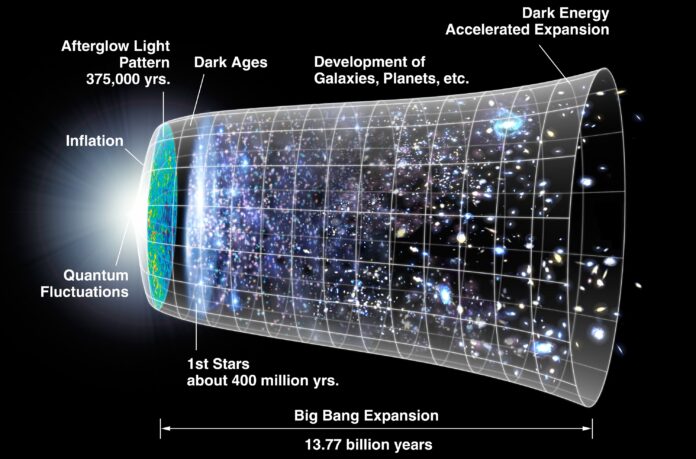The question of the origins of the universe has been a subject of fascination and inquiry for humanity for centuries. In the pursuit of understanding the cosmos, one theory has emerged as the leading explanation for the birth of our universe: the Big Bang theory. In this article, we explore the Big Bang theory, its supporting evidence, and the remarkable journey of cosmic evolution that has shaped the universe we observe today.
The Big Bang Theory
The Big Bang theory proposes that the universe originated from a single, incredibly hot and dense point roughly 13.8 billion years ago. This primordial state, often described as a “singularity,” marked the beginning of time, space, and all matter and energy in the cosmos.
According to the theory, the universe then underwent a rapid and exponential expansion known as cosmic inflation, during which it expanded at speeds exceeding that of light. As the universe expanded, it cooled down, allowing particles to form, and eventually, the first atoms began to coalesce.

Supporting Evidence
Numerous lines of evidence support the Big Bang theory:
1. Cosmic Microwave Background Radiation
One of the most compelling pieces of evidence for the Big Bang is the cosmic microwave background radiation (CMB). Discovered in 1965, the CMB is a faint glow of microwave radiation permeating the entire universe. It is the remnants of the intense heat from the early universe, cooled and stretched by the expansion of space.
2. Abundance of Light Elements
The Big Bang theory successfully predicts the relative abundance of light elements in the universe, such as hydrogen and helium. These elements were formed during the early stages of the universe, and their observed abundances match the theoretical predictions.
3. Redshift of Galaxies
The observation of redshift in the light emitted by distant galaxies provides evidence for the expansion of the universe. As the universe expands, the wavelengths of light from distant galaxies get stretched, causing them to shift towards the red end of the spectrum.
4. Large-Scale Structure
The distribution of galaxies and galaxy clusters observed in the universe today is another piece of evidence that supports the Big Bang theory. The formation of large-scale structures can be explained by the gravitational interactions of matter during the early universe’s expansion.
The Expanding Universe
The discovery of the universe’s expansion has profound implications for our understanding of cosmic history. As Edwin Hubble observed in the 1920s, galaxies are moving away from each other, indicating that the universe is not static but expanding.
The Fate of the Universe
The observed expansion raises questions about the fate of the universe. Depending on the amount of matter and energy in the cosmos, it can either continue to expand indefinitely or eventually slow down and contract under gravity—a scenario known as the Big Crunch. Recent observations suggest that the universe’s expansion is accelerating, possibly driven by an enigmatic force called dark energy.
Beyond the Big Bang: Cosmic Evolution
While the Big Bang theory explains the origins of the universe, it is just the beginning of the story. Over billions of years, the universe underwent a complex process of cosmic evolution, giving rise to the diverse structures and phenomena we observe today.
Formation of Stars and Galaxies
As the universe expanded and cooled, regions of higher density attracted more matter through gravitational pull. These regions eventually collapsed, giving birth to the first stars and galaxies. Within these galaxies, stars formed, producing the heavy elements necessary for planets, life, and complex structures to emerge.
The Role of Dark Matter and Dark Energy
The evolution of the universe is significantly influenced by two mysterious components: dark matter and dark energy. Dark matter, which does not emit light or interact with electromagnetic forces, plays a critical role in the formation of galaxies and large-scale structures through its gravitational effects.
Dark energy, on the other hand, is thought to be responsible for the accelerating expansion of the universe. Its nature remains one of the most significant mysteries in modern cosmology.
Stellar Life Cycle
Stars, born from the gravitational collapse of gas clouds, undergo a life cycle that includes fusion of hydrogen into helium, which releases energy, causing them to shine. Massive stars end their lives in spectacular supernova explosions, enriching the cosmos with heavy elements. These elements then become the building blocks for new stars, planets, and ultimately, life.
The Emergence of Life
The complex interplay of cosmic evolution and the conditions on our planet led to the emergence of life. The ingredients necessary for life, such as water, carbon, and other essential elements, were present in the universe from its early stages.
Conclusion
The Big Bang theory stands as the most robust explanation for the origins of the universe, supported by compelling evidence from cosmic microwave background radiation, the abundance of light elements, and observations of redshift in distant galaxies. However, the story of our universe extends far beyond its birth, encompassing a cosmic journey of evolution, from the formation of stars and galaxies to the emergence of life.
As we continue to explore the cosmos and push the boundaries of our understanding, the mysteries of dark matter, dark energy, and the ultimate fate of the universe await further exploration and discovery.


